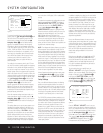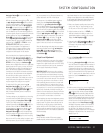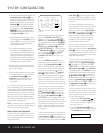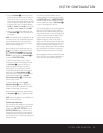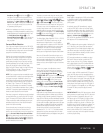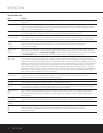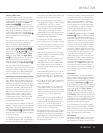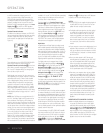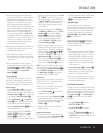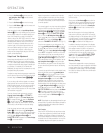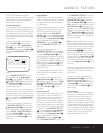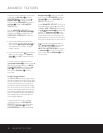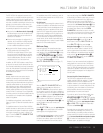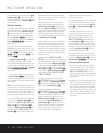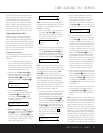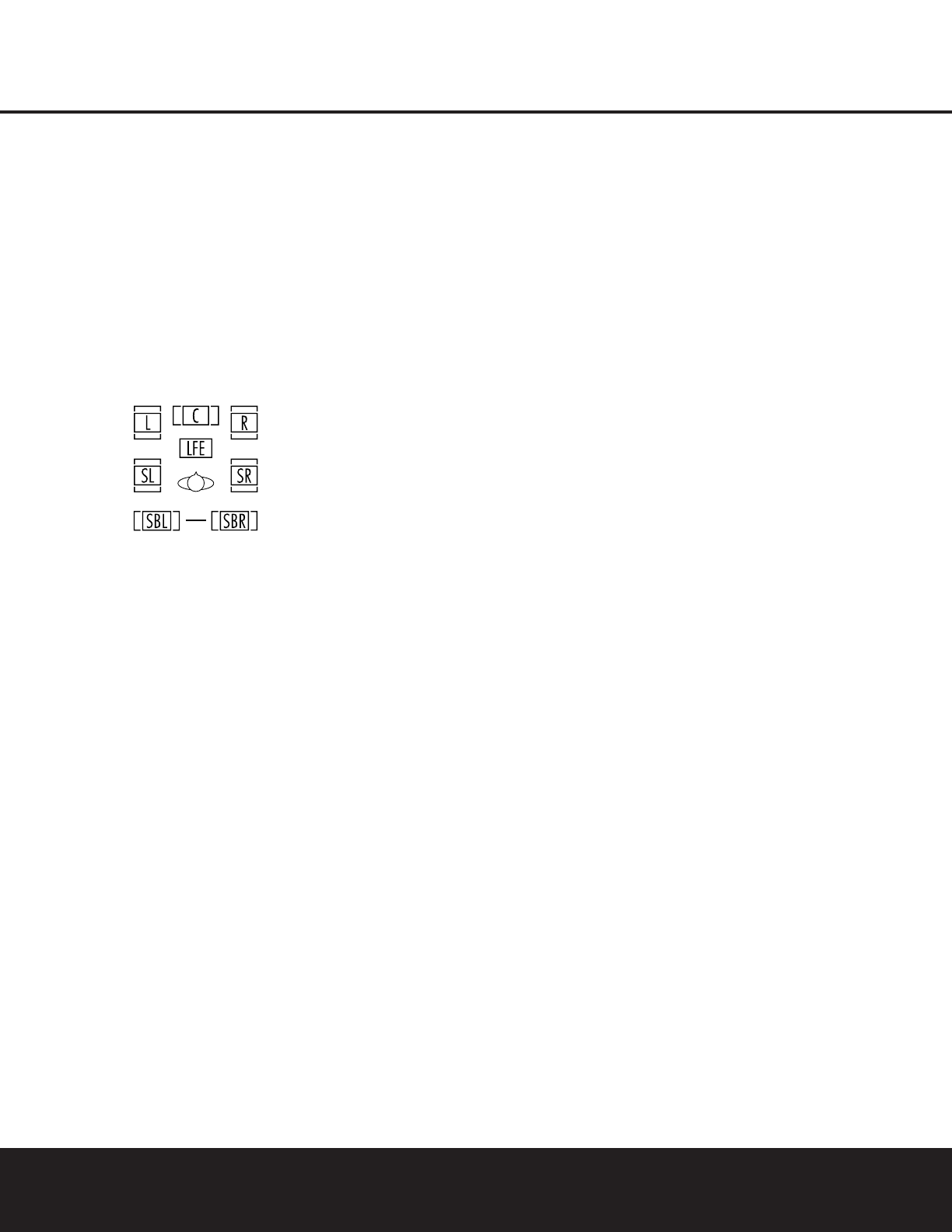
an HDCD-encoded disc is playing and the CD
player is connected using a digital connection, the
DPR 2005 will automatically recognize the HDCD
encoding and activate the circuits required for proper
playback, provided that the Surround Off mode is
selected. An HDCD message will appear in the
Lower
Display Line
& to confirm the HDCD playback.
HDCD playback is limited to two-channel stereo only.
Speaker/Channel Indicators
In addition to the bitstream indicators, the DPR 2005
features channel-input indicators that show how many
channels of digital information are being received
and/or whether the digital signal is interrupted (see
Figure 15).
Figure 15
These indicators are the L/C/R/LFE/SL/SR/SBL/SBR
letters that are inside the center boxes of the
Speaker/Channel Input Indicators % on the front-
panel. When a standard analog signal is in use, only
the “L” and “R” indicators will light, as
analog signals
have only left and right channels.
Digital signals, may have two, five, six or seven chan-
nels; depending on the program material, its method of
transmission and the way in which it was encoded.
When a digital signal is playing, the letters in these
indicators will light in response to the signal being
received. It is important to note that although Dolby
Digital, for example, is referred to as a “5.1” system,
not all Dolby Digital DVDs or programs are encoded
for 5.1. Thus, it is sometimes normal for a DVD with a
Dolby Digital soundtrack to trigger only the “L” and “R”
indicators.
NOTE: Many DVD discs are recorded with both “5.1”
and “2.0,” and Dolby Digital and DTS versions of the
same soundtrack. When playing a DVD, always be
certain to check the type of material on the disc. Most
discs show this information using icons on the back of
the disc jacket. When a disc offers multiple soundtrack
choices, you may have to make some adjustments to
your DVD player (usually with the “Audio Select” button
or in a menu screen on the disc) to send a full 5.1
feed to the DPR 2005 or to select between Dolby
Digital or DTS. It is also possible for the type of signal
feed to change during the course of a DVD’s play-
back. In some cases, the previews or special material
will be recorded in 2.0 audio, while the main feature is
available in 5.1 audio. The DPR 2005 will automatically
sense changes to the bitstream and channel count
and reflect them in these indicators.
The letters used by the
Speaker/Channel Input
Indicators
% also flash to indicate when a bitstream
has been interrupted. This will happen when a digital
input source is selected before the playback starts, or
when a digital source such as a DVD is paused. The
flashing indicators, along with the
UNLOCK mes-
sage in the
Lower Display Line &, remind you
that the playback has stopped due to the absence
of a digital signal and not through any fault of the
DPR 2005. This is normal, and the digital playback
will resume once the playback is started again.
Night Mode
A special feature of Dolby Digital is the Night mode,
which enables specially encoded Dolby Digital input
sources to be played back with full digital intelligibility
while reducing the minimum peak level by 1/4 to 1/3.
This prevents abruptly loud transitions from disturbing
others, without reducing the impact of the digital
source. The Night mode is available only when Dolby
Digital signals with special data are being played.
The Night mode may be engaged when a Dolby
Digital DVD is playing by pressing the
Night Mode
Button
T on the remote. Next, press the
⁄
/
¤
Navigation Button o to select either the middle
range or full compression versions of the Night
mode. To turn the Night mode off, press the
⁄
/
¤
Navigation Button o until the message in the
lower third of the video display and in the
Lower
Display Line
& reads D-RANGE OFF.
The Night mode may also be selected to always be on
at either level of compression using the options in the
DOLBY SURR menu. See page 23 for informa-
tion on using the menus to set this option.
MP3 Audio Playback
The DPR 2005 is one of the few receivers equipped
for onboard decoding for the MP3 audio format used
by computers and portable audio devices. By offering
MP3 decoding, the DPR 2005 is able to deliver pre-
cise conversion of the digital signals to an analog out-
put, along with the benefits of listening to the MP3
audio through the DPR 2005’s high-power amplifier
and the speakers from your surround system, rather
than the smaller speakers and low-powered amplifiers
typically used with computers.
To take advantage of the DPR 2005’s MP3 capabili-
ties, simply connect the S/P-DIF output of a comput-
er’s sound card or the S/P-DIF output of a portable
digital audio device to either the rear panel
Digital
Inputs
fl‡
or the front-panel Digital Inputs
HJ. When the digital signal is available, the Lower
Display Line
& will indicate that an MP3 bitstream
is present, and the audio will begin playing.
NOTES:
• The DPR 2005 is only capable of playing signals in
the MP3 (MPEG 1/Layer 3) format. It is not com-
patible with other computer audio codecs.
• The digital audio input signal may be either optical
or coaxial, but the signal must be in the S/P-DIF
format. Direct connection of USB or serial data
outputs is not possible, even though the signals
are in the MP3 format. If you have any questions
about the data output format from your computer
or a sound card, check with the device’s owner’s
manual.
• If your computer or sound card’s digital output is not
capable of direct connection to the DPR 2005, you
may use an optional, external transcoder to convert
the USB output of a computer to a format compati-
ble with the DPR.
• Due to the wide variation in MP3 formats and
encoding speeds, it is possible that the DPR 2005
may not be compatible with all MP3 input signals.
Some may produce unacceptable results or may
not be decoded. This is not a fault of either the
computer or the DPR 2005, but rather a by-product
of the unpredictable nature of MP3 playback.
• Even when your computer does not have a digital
output that is compatible with the DPR 2005, you
may connect the analog audio output available on
virtually all computers to one of the DPR’s analog
audio inputs using an optional adaptor cable that
converts the stereo mini plug commonly used for
computer audio connections to the left/right RCA
jacks used on the DPR. Connecting your computer
to the DPR will enable you to take advantage of
the high-quality audio reproduction possible with a
home theater system, as well as enable the use of
surround processing modes such as Logic 7, to
greatly enhance downloaded or streaming audio
playback.
IMPORTANT NOTES ON DIGITAL PLAYBACK:
• When the digital playback source is stopped, or
in a pause, fast forward or search mode, digital
audio data will momentarily stop, and the channel
position letters inside the
Speaker/Channel Input
Indicators
% will flash and an UNLOCK mes-
sage may appear. This is normal and does not indi-
cate a problem with either the DPR 2005 or the
source machine. The DPR 2005 will return to digital
playback as soon as the data is available.
OPERATION
34 OPERATION



